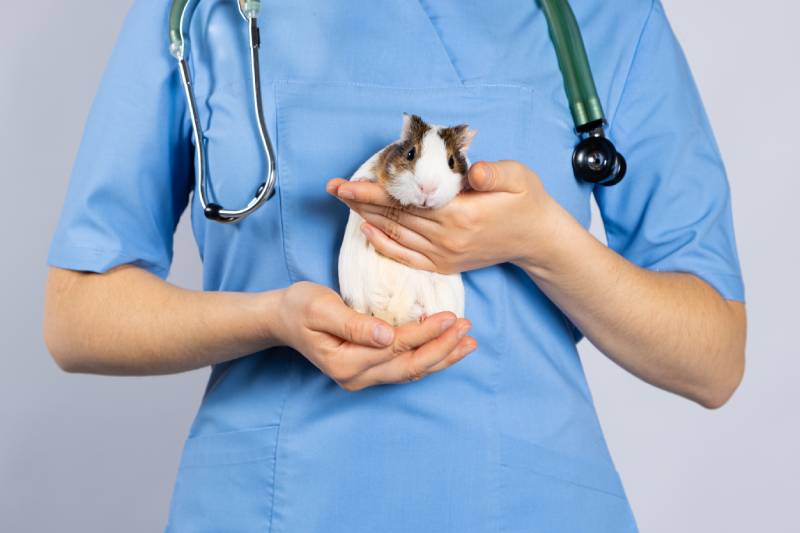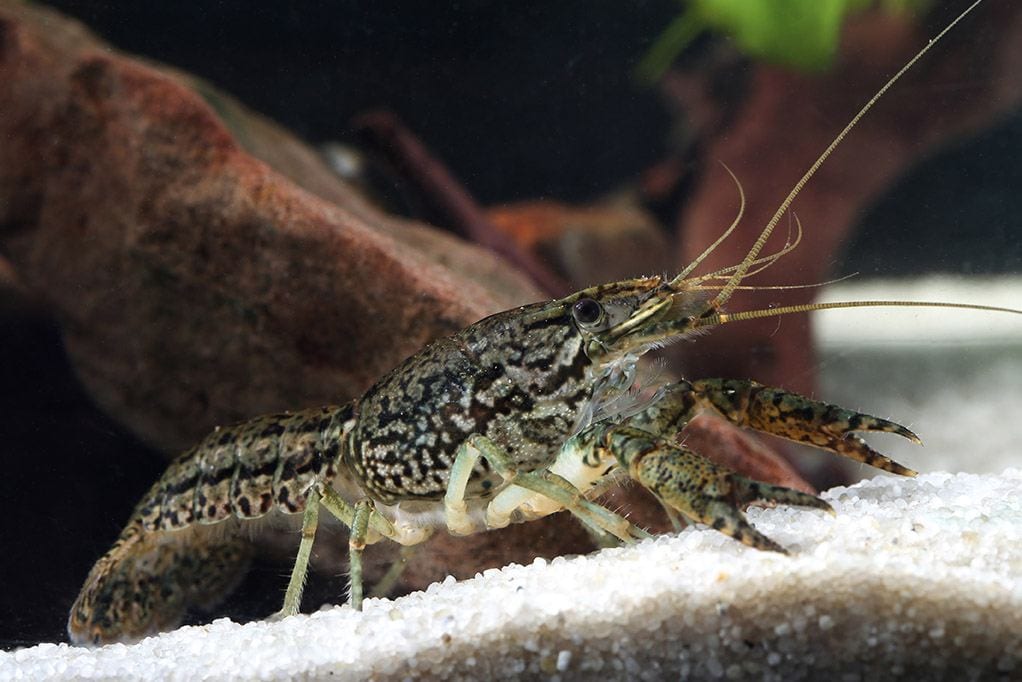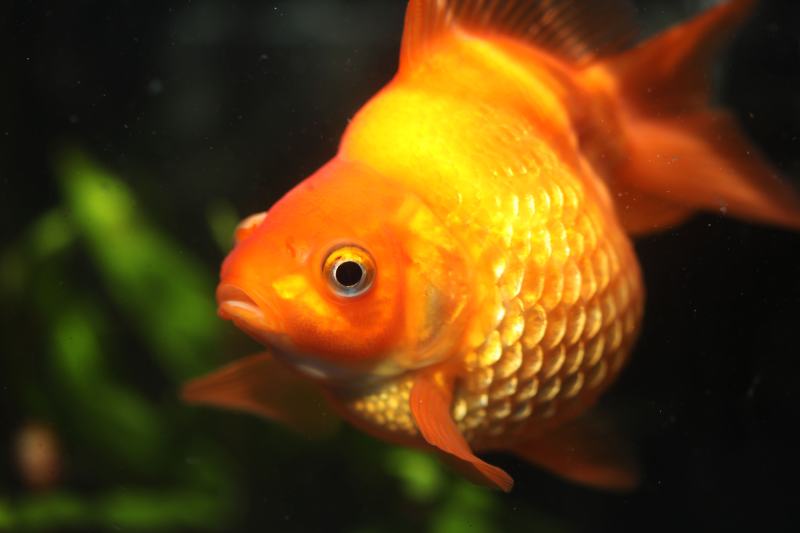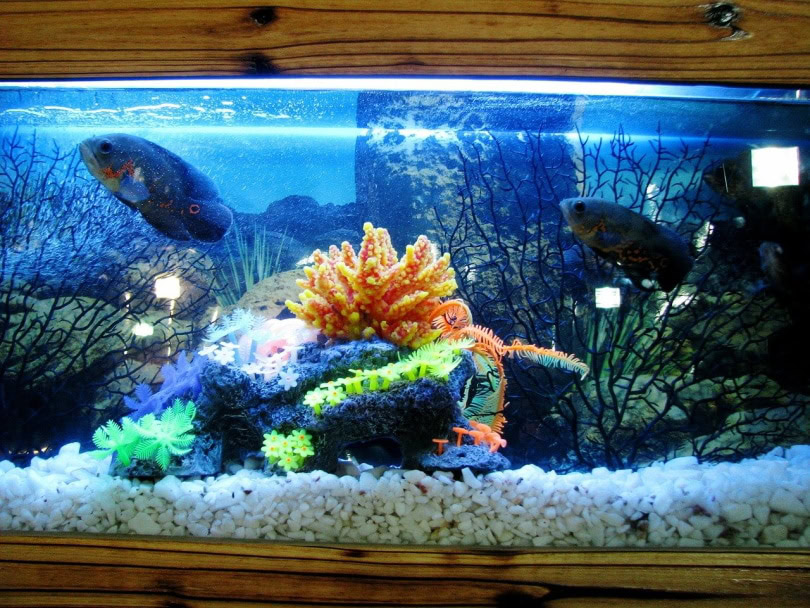VET APPROVED

The information is current and up-to-date in accordance with the latest veterinarian research.
Learn more »Click to Skip Ahead
Guinea pigs are fascinating and lovable little rodents that many love to keep as pets and companions. They are often referred to as “cavies” by people devoted to the little critters. They are unlike rats and mice in that they are crepuscular rather than nocturnal. This means they are most active at dusk and dawn, making them ideal pets because they should not wake up their owners at night with their rustling and bustling.
Due to their specific life history and habits, guinea pigs’ eyes differ in certain ways from those of other rodents. These differences can make them more susceptible to particular eye conditions and diseases.
We compiled this list of guinea pig eye problems that are most likely to occur. This is not an exhaustive list, however, and other unusual conditions exist. If your cavy has a problem with their eyes that matches any of the conditions described here, it is wise to seek immediate veterinary advice.

Guinea Pig Eye Overview
The guinea pig’s eye structure differs from that of other rodents and bears some similarities to that of humans. For example, their crepuscular habits result in poorer night vision than some of their nocturnal counterparts. As a prey animal, their eyes are set on either side of their head, meaning they have poor depth perception. They also blink infrequently and may be seen sleeping or resting with their eyes open. Although they have mechanisms to protect their eyes, their infrequent blinking, low tear production, and poor corneal sensitivity may result in them being prone to certain eye conditions.
We divided this list into two parts, as some of the problems that guinea pigs experience with their eyes result from issues in other parts of their body. We look at the issues directly involving their eyes, and then we explore other conditions that can cause eye problems.
This list includes the health signs and suggested treatments for all the outlined conditions. However, this information is not a substitute for a visit to a veterinarian. If your guinea pig displays any of the signs here, you should immediately make an appointment for them to see your veterinary specialist.

The 6 Direct Problems With Guinea Pigs’ Eyes
1. Foreign Body in the Eye
A foreign body lodged in the eye can be uncomfortable and painful and can have serious consequences. Since guinea pigs have such low corneal sensitivity, they may not attempt to dislodge it timeously. It could injure the corneal surface and result in corneal ulceration.
Signs & Treatment
A guinea pig with a foreign body lodged in their eye may not show any signs until the object has caused trauma to the eye. By then, they may develop a weepy eye that they keep closed or half-closed, or they may blink more often than usual. You may notice the foreign object before your guinea pig does.
If you suspect or notice a foreign body in your cavy’s eye, you should get your veterinarian to help as soon as possible. If a secondary condition develops, such as a corneal ulcer, it must be treated.
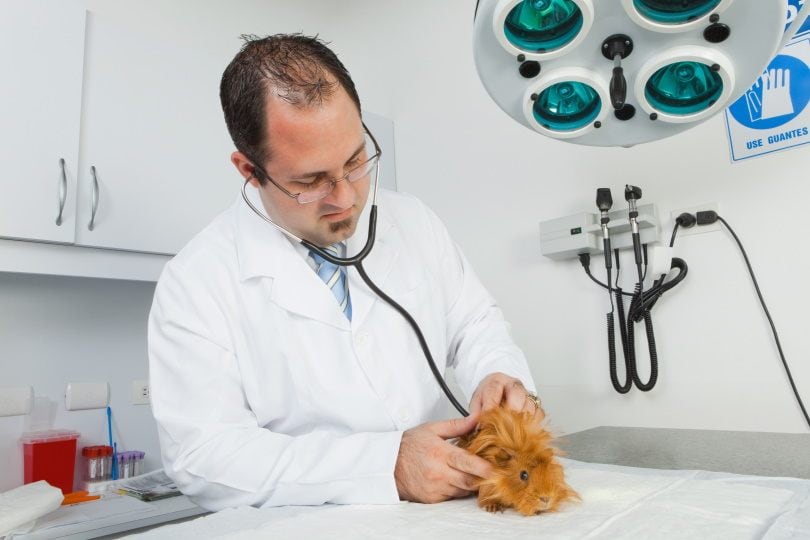
2. Corneal Ulcers
Corneal ulcers usually develop following a minor injury to the eye’s surface, such as a scratch from a piece of hay or sawdust. Entropion can sometimes cause corneal ulcers, but this is rare in guinea pigs. Unfortunately, these rodents have extraordinarily underdeveloped corneal sensitivity and a correspondingly low reaction to corneal irritants. Scratches to the cornea are, therefore, all too common. Not all eye trauma results in corneal ulcers, though.
Signs & Treatment
Signs of a corneal ulcer include a tightly closed eye with pain, discharge, or a cloudy appearance. Sometimes it’s even possible to see the corneal injury or ulcer with your naked eye.
Treatment depends on the depth and size of the corneal ulcer. It may involve the application of eye drops or ointments to your cavy’s eye, at the direction of your veterinarian, until the condition clears up. Deeper or bigger corneal ulcers may require surgery. Your vet will advise you on the best course of action.
3. Conjunctivitis
Conjunctivitis, or pink eye, is a relatively common eye condition in guinea pigs that is most commonly caused by bacterial infection or low vitamin C levels. Both conditions result in the inflammation of the mucus membranes that line the eyelids.
Signs & Treatment
Signs of conjunctivitis include a reddening of the afflicted mucous membranes and the sclera (the white part of the eye). The guinea pig may blink more often or even close their eye, paw at their face, and develop a clear or white discharge. Conjunctivitis may affect one or both eyes, and the eyelids and membranes may also become swollen.
- Topical antibiotic ointments
- Saline eyedrops to flush out discharge and accumulated debris
- Vitamin C supplementation
- Anti-inflammatory eyedrops
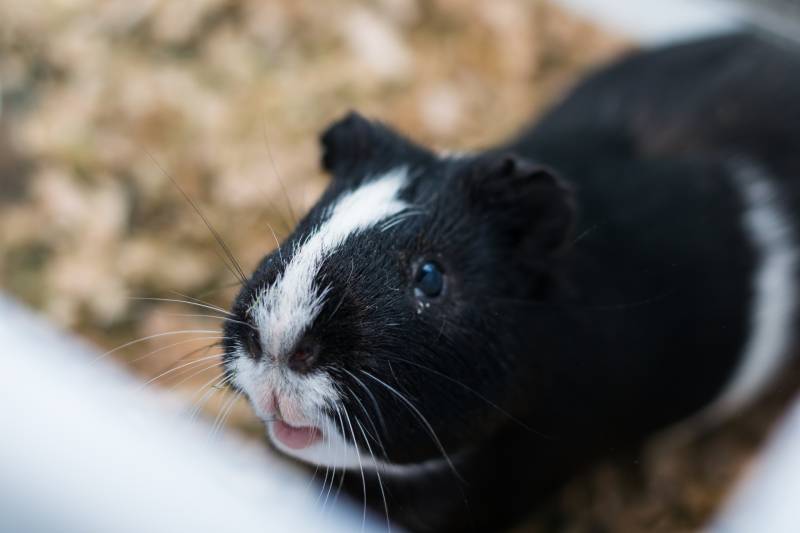
4. Pea Eye
Pea eye, also known as fatty eye, is a protrusion of the mucosa of the lower eyelid or portions of the lacrimal gland. It is a permanent condition that doesn’t cause the guinea pig pain or discomfort. It is believed to be a genetic condition and usually doesn’t require treatment. Some experts believe that it can develop following an infection or be linked to obesity in guinea pigs.
Signs & Treatment
The affected eye will exhibit a “droopy” lower eyelid with pale pink or white swelling on the inner mucosa. Treatment is only necessary if the protrusion becomes reddened or the eyes begin to weep or discharge. This indicates that an infection has developed that will require veterinary attention immediately.
5. Dry Eye (Keratoconjunctivitis Sicca)
Dry eye, or keratoconjunctivitis sicca (KCS), is an infrequent eye condition in guinea pigs. It may develop when there is a decrease in tear production. A dry eye might be irritating and painful to the guinea pig.
Signs & Treatment
A guinea pig afflicted with KCS may show signs of discomfort and pain. The eye may remain partially closed, and there may be a clear, slimy discharge. If a secondary infection has set in, there could be pus discharge or crusty build-up around the eye. The eye may also appear dull.
Your veterinarian may prescribe eye drops to keep their eyes lubricated. If an infection has set in, your vet will probably set up an additional course of treatment, possibly involving antibiotic therapy.
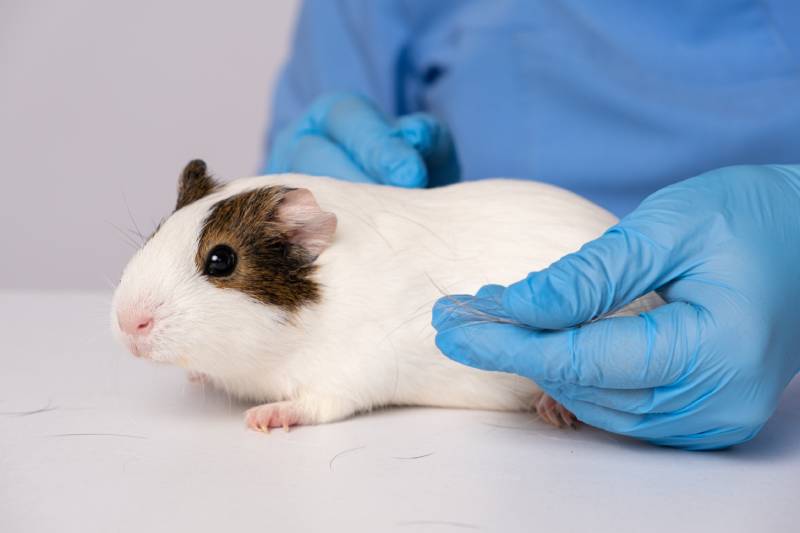
6. Entropion
This is an infrequent condition in guinea pigs. A cavy with entropion is usually born with it. The eyelid turns toward the eye, causing hairy skin to rub against the eyeball. In severe and untreated cases, it can result in corneal ulceration.
Signs & Treatment
The afflicted eye will be uncomfortable and have various amounts of discharge, which may include pus if a secondary infection or ulcer develops. Ingrowing eyelashes can be observed in cavies afflicted with entropion.
This condition usually requires surgery to correct, but in the meantime, your vet will probably recommend lubricating eye drops to ease irritation. If the condition does not self-rectify, surgery will be required.
The 3 Problems in Guinea Pigs’ Eyes Resulting From Other Conditions
7. Dental Issues
The guinea pig’s tear duct is near the roots of their molars. Sometimes when there are issues with these teeth, such as an abscess, the tear duct or the eye socket (the orbit) may be affected.
Signs & Treatment
Signs of dental-related eye problems are similar to those that emanate in the eye, including a watery or cloudy discharge and eye sensitivity. If your guinea pig’s eye problem is accompanied by a reluctance to eat or weight loss, it might be a dental issue. Your vet will need to confirm this and then treat it accordingly. For example, antibiotics may be administered to treat an abscess, or filing the teeth may be necessary.
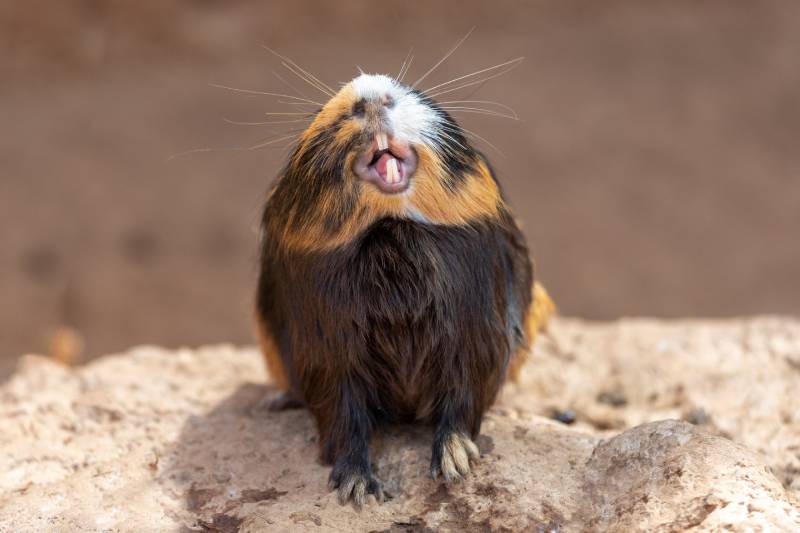
8. Respiratory Conditions
A respiratory condition, or upper respiratory tract infection (URI), can also result in irritated, watery, or crusty eyes. In severe cases, pneumonia can develop. This is a serious condition that requires immediate veterinary intervention.
Signs & Treatment
Besides watery or crusty eyes, a guinea pig with a URI may have a snotty nose. Coughing, sneezing, and general lethargy are additional signs. If your guinea pig is having difficulty breathing, it may be a sign that the infection has reached the lower respiratory tract.
All these conditions are serious and require immediate veterinary attention. Your vet will prescribe a course of medication that will probably include antibiotics and medicines to ease their associated signs.
9. Tumor
Although the development of tumors in guinea pigs is relatively common as they get older, tumors in the head, behind the eyes, or in the brain are less so. However, it has been known to happen.
Signs & Treatment
A tumor in the head or brain can put pressure on the eyes, which may begin to bulge. This also affects the lacrimal gland and the ability of the eyelids to close over the eye. With these compromised, the eyes will become exposed and dry. They may become cloudy and develop a discharge as a consequence. A tumor directly behind the eye may put pressure on the optic nerve, causing blindness.
Tumors are difficult to diagnose. Sometimes they can be identified via an X-ray, but they often don’t show up. An MRI may provide a diagnosis, but understandably, this is not a route that many cavy owners pursue. Unfortunately, a tumor in the head or behind the eyes is generally untreatable.
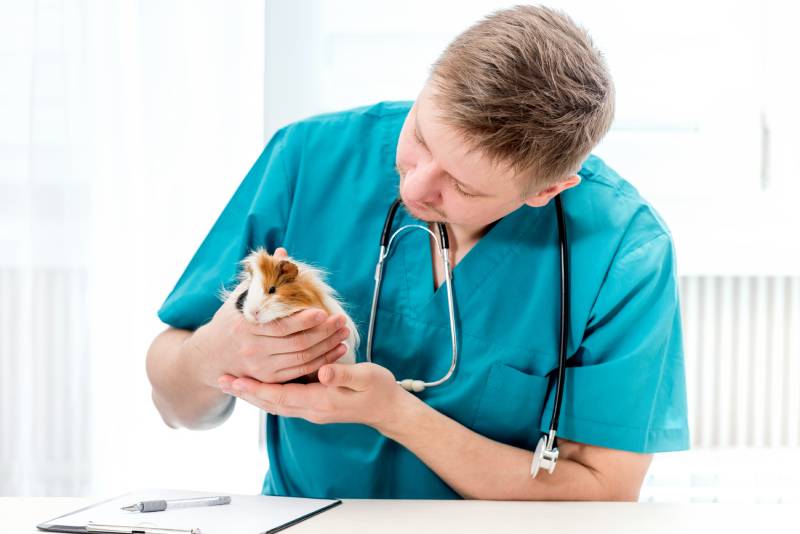

Tips to Help Keep Your Guinea Pig’s Eyes Healthy
Due to the inherent physiological and behavioral characteristics of guinea pigs, it’s not always possible to ensure your cavy’s eye health. However, the likelihood of certain conditions developing can be minimized with the correct care.
- Ensuring that their enclosure is a safe and clean environment free of dangerous objects, dirt, and dust is a good start. It is vital to provide them with fresh bedding, good-quality food, adequate vitamin C levels, and a constant supply of fresh water. Make sure you don’t overfeed your guinea pig. This might lead to obesity, which is not only bad for eye health but can also result in myriad other health issues.
- If you have two or more guinea pigs, you should keep an eye on them, ensuring that they have enough space and never fight with one another.
- Lastly, pay careful attention to your guinea pig’s eyes. If they ever change in appearance, it may be a sign that an infection or condition is developing. It is best to have them diagnosed and treated sooner rather than later. As soon as you notice any changes, get your cavy checked out by your vet.

Conclusion
Guinea pigs don’t have a great track record when it comes to eye health. It’s a good idea to research some of the eye problems that may afflict them during their life. This will prepare you if your pet ever experiences any eye issues while they are under your care.
We hope that this article has provided enough information to make you feel confident about handling eye conditions that your guinea pig may deal with.
- Keratoconjunctivitis sicca | Vetlexicon
- Ocular Surface Disease in Rodents (Guinea Pigs, Mice, Rats, Chinchillas) – PMC
- Management of Corneal Ulcers in Small Animals – WSAVA2007 – VIN
- Pink Eye in Guinea Pigs | PetMD
- My guinea pig has a sore eye – what should I do? – Vet Help Direct
- Ocular disease in the guinea pig (Cavia porcellus): a survey of 1000 animals
- Schirmer tear test, phenol red thread tear test, eye blink frequency and corneal sensitivity in the guinea pig
Featured Image Credit: Garna Zarina, Shutterstock
